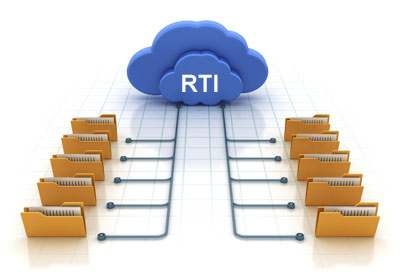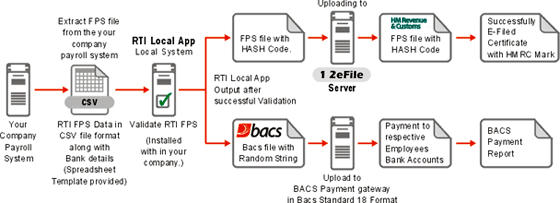RTI (Real Time Information) E-Filing
1 2eFile provides user friendly, comprehensive and cost effective RTI eReturns to HMRC. The system will cover all RTI eReturns and eReceipts you need, regardless of whether you use EDI or XML channels for your data interchange with HMRC. You can use our system for LIVE testing against HMRC's RTI Live server at any time.
Our system is not only the first to gain HMRC recognition, it has also been successfully used by members. More details about our system are as follows.
1. System Compatibility
SAP, Oracle, bespoke and other software package users have been successfully using our system for their various eReturns to the HMRC. The system is platform independent, cloud-based, and will be compatible with any system and any version of HR and Payroll you use.
The file formats the system supports for RTI eReturns to HMRC are:
CSV XML


2. The Range of RTI eReturns / eReceipts Supported
We support the full range of RTI Data eReturns and eReceipts, plus other additional services.
Complete range of RTI eReturns included are
- FPS, Full Payment Submission
- EPS, Employer Payment Summary
- NVR, NINo Verification Request
- EYU, Earlier Year Updates
- BACS files embedded with a 4 Character String which will work with your BACS system
- The FPS file will be embedded with a Hash Code in conjunction with HMRC's algorithm
- P11D
- P46 Car
Complete range of RTI Data eReceipts (DPS) included are
- P6, P9, SL1, SL2, NINO Notices.
- EDI and XML channels are supported.
RTI Additional Services
- Produces Leaver P45 Data / PDFs for printing out.
- Produces Year End P60 Data / PDFs on Completion of Final FPS
- e-Payslips
Others
- Supports daily, weekly, monthly, annual and anytime etc, pay run data.
- Compatibility with your system is assured as it is 100% browser-based.
- Many users have used the system successfully. It is very stable and reliable.
3a. How does e-filing of Returns Work?
You may e-file your FPS, EPS, EYU and NVR returns with the www.1 2eFile.com specialist eReturn system using a CSV file or an XML file. However, different file formats require different preparation. This section explains what may be involved when using different file formats for your returns.
3.1 - CSV File Format Approach
The steps involved to e-file your RTI returns using a CSV file are as follows:
Step 1: Download the template Excel spreadsheet for the respective return you wish to make from 1 2eFile.com or obtain it from our BACS partner CD.
Step 2: Based on the template's specified data requirements you need to derive the data from the payroll system you use and place the data onto the template spreadsheet. The specifications for the data are given in the instructions which you can also download from our website or obtain from our BACS partner CD.
Step 3: Check the Excel Spreadsheet containing all your data is in accordance with the instructions we specified. Our specifications are based on HMRC's Schema specification as well as BACS Standards.
Step 4: Convert the Excel Spreadsheet into a CSV file.
Step 5: Upload the CSV file to www.1 2eFile.com Server
Step 6: Make a final check on the uploaded RTI data and approve the data, or remove the data if your data contains errors and then repeat the uploading process when you are happy with the data.
Step 7: Click on the E-file button. Wait a few minutes and then you will be able to download the E-filed Success Certificate, which contains the HMRC Timestamp and HMRC IR MARK.
3.2 - XML file Approach
The steps involved in e-filing your RTI eReturns through XML file. A XML file will come from a payroll package with the capability of producing the XML output inbuilt. The XML file in question must be fully in compliance with HMRC's various RTI required data specifications
Step 1: After completing the pay run you can produce the XML file in your system
Step 2: Sign in to the www.1 2eFile.com server and upload your XML file
Step 3: Make a final check on the uploaded RTI data and approve it, or remove the data if your data contains errors and then repeat the uploading process when you are happy with the data.
Step 4: Click on the E-file button. Wait a few minutes and then you will be able to download the E-filed Success Certificate, which contains the HMRC Timestamp and HMRC IR MARK.
Notes:
a. BACS Random Strings and FPS Hash Codes:
For XML files your system must already have produced the BACS Random String and Hash Code concerned and we will not duplicate what you already have. However, for the CSV file approach we will help to generate the BACS Random Strings in conjunction with the FPS file Hash Codes.
3b. How Does RTI eReceipts Work?
www.1 2eFile.com will automatically unload all these notices for you into the 1 2eFile server for you to view. We will also convert the above mentioned files into CSV formats. You can download the P6, P9, SL1, SL2 and NINO notices in a CSV format and then upload them to your payroll system for auto-tax code updates. However, to achieve auto-tax code or NINO updates you need to ask your software engineer to help you to map the data directly into your database.
Under RTI HMRC will send you various notices through its Data Provisioning Service (DPS). These notices include
P6 P9 SL1 SL2 NINO

RTI eReturns - What and When to e-File
1. Full Payment Submission (FPS)

This is the regular return you need to make after you have made the first and second returns. Your need to make a FPS return whenever you make a wage payment to an employee, be it monthly, weekly, 2 weekly or 4 weekly. Each pay frequency has its own respective FPS return. The process of making this return is the same as the first and second returns i.e. you simply download the template from www.1 2eFile.com and then populate the data into it. Once you upload the data to www.1 2eFile.com it will e-file the documents for you. This service is not free.
Our system also helps you to generate the BACS file automatically, with the correct algorithm specified by HMRC i.e. the 4 character random string attached to the BACs and the corresponding HASH CODE at the FPS. We support the following BACS outputs.
2. Employer Payment Submission (EPS)

This is the second document you need to e-file to HMRC after you have e-filed the EAS. In this document you need to include all employees with all pay frequencies and their respective payments. The process for e-filing this return is the same as the first EAS return i.e. first you download from www.1 2eFile.com the given spreadsheet template which defines all the data you require. Extract the data from your system and place it into the spreadsheet and then further upload it back to the www.1 2eFile.com server. The server will automatically convert your data into HMRC's required XML format and then e-file it for you automatically for FREE.
3. Earlier Year Update (EYU)
This submission is used to correct errors made in a previous tax year. Errors made in the current tax year are corrected in the payroll system and then reported via either an amending FPS, or the next normal FPS.
The EYU is only used when an error on the FPS is noticed on or after 20 April in the following tax year. The EYU shows only the amendments to be made to the relevant year-to-date figures for an employee.
4. NINO Verification Service (NVR)

This allows employers to validate or obtain a new employee NINO. The process is similar to the above i.e. download the template from www.1 2eFile.com and then upload it back to 1 2eFile to e-file the details. After e-filing you need to log on to www.1 2eFile.com to view and/or download the responses from HMRC. The process is conducted through something known as the Data Provisioning Service (DPS). The download we will give you is in a CSV file for you to further upload to your system to update your employees' NINOs.
5. Auto Tax Code Update DPS

We can also help you do auto tax code updates from your P6 and P9. This system is proven and has been used successfully by many very large employers since 2006. Once you click the button on our www.1 2eFile.com system, we will go to the HMRC server to fetch your tax codes, then convert them to a CSV format for you to upload to your server to conduct the auto tax code updates. This is done under the HMRC DPS system. The system supports the data of up to 250,000 employees.